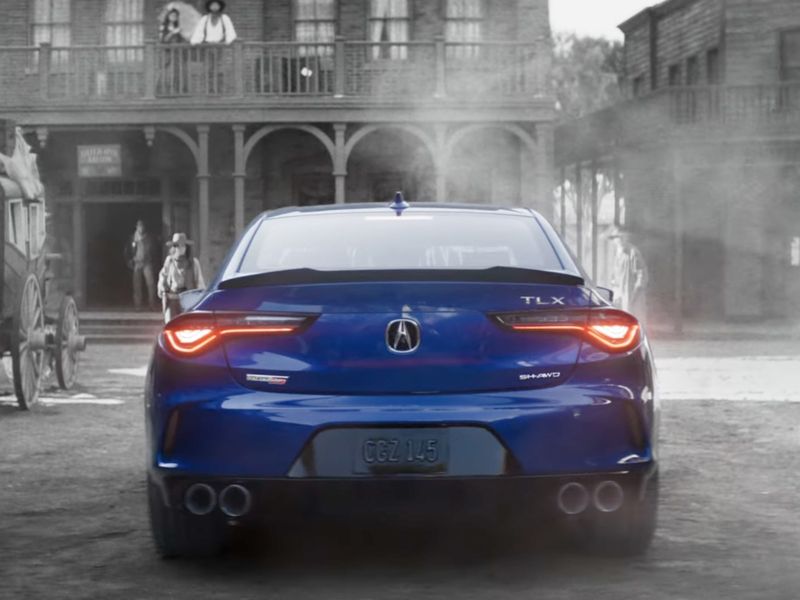
Acura faces headwinds on multiple fronts as it tries to drum up interest in its new TLX sedan, which hits dealers Monday.
The luxury segment the car competes in remains mired in a pandemic-induced sales slump. And sedans continue to lose ground to SUVs and crossovers as buyers gravitate to higher-riding vehicles.
But those forces are not stopping Honda Motor Co. from pouring significant marketing behind its premium brand with an ad approach executives hope rises above the sedan clutter.
A new ad from MullenLowe Los Angeles hitting the airwaves Sunday turns the clock back to the silent-film era. A blue TLX appears as the only colored image in the black-and-white ad as it barrels through clichéd silent movie scenes, including a western shootout. A man driving the car outruns a locomotive to rescue a damsel in distress tied to railroad tracks. The soundtrack is “It’s Oh So Quiet,” a song released in the 1950s by comedic actress and singer Betty Hutton.
The spot, called “Break the Silence,” is part of Acura’s larger “Less Talk, More Drive” campaign that debuted last year and puts an emphasis on visuals over dialogue, including an action-packed spot called “Beat That.” The approach is more easily transferable to digital marketing, where brands must capture the attention of viewers in mere seconds.
“When you have four seconds to catch somebody, it’s got to be visually fresh — you should have music that gets everybody’s attention,” says Acura Brand Officer Jon Ikeda. “If you just break into monologue, it’s very quick that they might turn you off.”
Setbacks during the pandemic
Acura’s media plan includes ad buys with Verizon Media-owned digital brands Yahoo, Tech Crunch and Huffington Post. The campaign will also get a heavy TV push, including buys during National Football League and National Basketball Association programming.
The investment comes as luxury auto brands seek to spur demand after suffering setbacks during the pandemic, which forced the closure of showrooms and forced buyers to watch their spending more carefully.
U.S. luxury vehicle sales fell 35 percent in the second quarter, according to Cox Automotive. Cox, which consults with more than 40,000 auto dealer clients globally, in a recent report projected that “the luxury market— particularly the very high end — would be among the last vehicle segments to recover since luxury vehicles are a discretionary purchase and can be delayed. Many are leased, and leases were extended as people couldn’t return to showrooms to select their next vehicle.”
Acura’s U.S. sales fell 19 percent to 82,713 deliveries through August and, within that total, sedan sales plunged 21 percent to 21,956 deliveries.
Acura’s approach has been to avoid the word “luxury”—instead using phrases including “precision crafted performance.” The verbiage is part of its attempt to separate itself from the more mainstream Honda brand, while giving it a different spin than other luxury brands including BMW, Mercedes-Benz, Lexus and others. “We are a performance division of Honda … so we need to show more action,” Ikeda says. “We took the luxury word out of everything, because we saw that that the ‘L’ word means so much to so many people that it was confusing how we wanted to portray ourselves.”
The 2021 Acura TLX has a starting price of $38,525, which is up from the base price of $34,025 for the 2020 model, according to Automotive News. TLX sales fell 23 percent to 13,273 deliveries through August, Honda said in its recent monthly sales report.
From sedans to SUVs
The drop comes structural changes in the automotive market in which buyers are moving out of sedans to SUVs and crossovers. The SUV/crossover share of the U.S. auto market has grown from 43 percent in 2017 to 51 percent this year, with traditional cars now at 24 percent, according to consultancy AlixPartners. (Trucks and vans account for 25 percent.) The firm projects the share of cars to fall to 20 percent by 2027, with SUVs/crossovers taking 56 percent.
Acura’s strategy is to grab a growing share of the shrinking market by making its car design stand out. As the “segment just keeps shrinking, the people that are left—that are buying these sedans—are real sedan fans,” Ikeda says. “So what we as a company have to do best is deliver on that promise on what an enthusiast sedan owner would want.”
That has meant discontinuing its larger RLX sedan, and redesigning the TLX. Says Ikeda: “It’s very unique in size and proportion for how wide it is to how low it is. We are really trying to make it easy for that enthusiast—the people who are left, that really like sedans—to go ‘that one is different, that one is unique.’ We have to make sure that our ads and things promote that.”